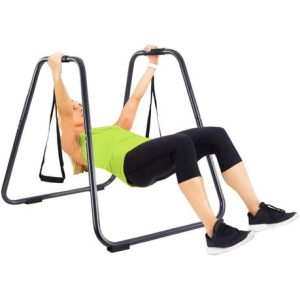Dip bars are a versatile piece of equipment commonly found in gyms, calisthenics parks, and even home setups. They offer a fantastic way to strengthen and tone your upper body, specifically targeting the chest, triceps, and shoulders. Whether you’re a beginner starting your fitness journey or an advanced athlete looking to push your limits, dip bars provide endless possibilities for progressions.
In this blog post, we’ll explore a range of dip bar progressions suitable for all fitness levels. We’ll begin with beginner-friendly exercises and gradually advance to more challenging variations, ensuring you have a clear roadmap for your dip bar training. So let’s dive in and discover the exciting world of dip bar progressions!
Table of Contents
Dip Bar Basics
Before we delve into the progressions, it’s essential to understand the fundamentals of dip bar training. The basic dip exercise is an excellent starting point. To perform a dip, grab the bars with an overhand grip, lock your elbows, and support your body weight. Lower yourself until your elbows are bent at a 90-degree angle, then push yourself back up to the starting position. Mastering proper form and technique is crucial to avoid injuries and maximize the benefits of dip bar exercises.
Beginner Progressions
a) Assisted Dips: If you’re new to dip bar training or lack upper body strength, assisted dips can help you build confidence. Use a resistance band or an assisted dip machine to lighten the load and gradually reduce the assistance as you get stronger.
b) Negative Dips: Negative dips focus on the eccentric (lowering) phase of the movement, which helps develop strength. Begin at the top position and slowly lower yourself down for an extended count. Step onto a platform or have a partner assist you in returning to the starting position.
c) Bench Dips: This variation can be performed on parallel bars or using two sturdy benches. Sit on the edge of the bench, grip the edges with your hands, and extend your legs forward. Lower yourself until your elbows are bent at a 90-degree angle, then push back up. Bench dips provide a manageable starting point while still engaging your target muscles.
Intermediate Progressions
a) Standard Dips: Once you’ve built a solid foundation, progress to standard tricep dips. This exercise requires more strength and stability as you lift your entire body weight. Focus on maintaining a vertical torso and controlled movement throughout.
b) L-Sit Dips: Take your dip bar training up a notch by incorporating the L-sit position. Begin with your legs extended in front of you and your body in a seated position. As you lower yourself, keep your legs straight and parallel to the ground, engaging your core for stability.
c) Ring Dips: Ring dips challenge your stability and engage additional muscles due to the instability of the rings. Using gymnastic rings instead of fixed bars forces your stabilizing muscles to work harder, providing a more intense workout for your upper body and core.
Advanced Progressions
a) Weighted Dips: To further increase the intensity, add extra weight by using a dipping belt accessories or holding a dumbbell or weight plate between your legs. Start with a manageable load and gradually increase the weight as you gain strength.
b) Muscle-Ups: Muscle-ups combine a pull-up and a dip into one fluid movement. Begin with a pull-up, then transition into a dip at the top position. This exercise requires excellent upper body strength and coordination.
c) Planche Dips: Planche dips are an advanced variation that requires exceptional strength and balance with your hands positioned further back on the bars, lean forward, and lower your body while maintaining a horizontal position. This places a significant demand on your shoulders, core, and upper body strength.
d) Single Bar Dips: Once you’ve mastered standard dips, challenge yourself by performing dips on a single bar instead of parallel bars. This variation requires increased stability and control, as you balance your bodyweight on a narrower surface.
Safety Tips and Precautions
As with any exercise, it’s essential to prioritize safety during your dip bar progressions. Here are some tips to keep in mind:
a) Warm-up adequately: Before diving into your dip bar routine, perform a dynamic warm-up to increase blood flow, loosen up your joints, and activate your muscles.
b) Progress gradually: Don’t rush the progression process. Gradually increase the difficulty of the exercises as your strength and proficiency improve. This approach will minimize the risk of injury.
c) Maintain proper form: Focus on maintaining proper form throughout each exercise. Keep your core engaged, shoulders down and back, and elbows in line with your wrists. Avoid excessive swinging or arching your back.
d) Listen to your body: Pay attention to any discomfort or pain during your dip bar training. If you experience joint pain or strain, take a break, and seek guidance from a qualified fitness professional.
Conclusion
Dip bar progressions offer a fantastic way to challenge yourself and take your upper body strength and stability to new heights. Whether you’re a beginner or an advanced athlete, there are variations suitable for every fitness level. By following a systematic approach and gradually increasing the difficulty, you can continue to progress and achieve your fitness goals.
Remember to prioritize safety, focus on proper form, and listen to your body throughout your dip bar training journey. With consistent practice and dedication, you’ll witness significant improvements in your upper body strength, muscle tone, and overall fitness.
So, embrace the dip bar and embark on an exciting journey of progression and transformation. Push yourself, stay committed, and enjoy the rewards of a strong and sculpted upper body. Happy dipping!
